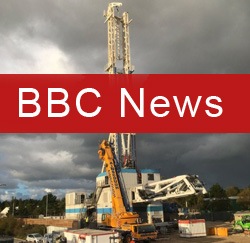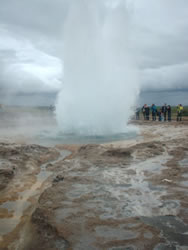Can't see the menu?
Try the text links at the bottom.
Energy Resources:
Geothermal power
Geothermal:
Heat energy from underground

| See a Polish translation of this page The centre of the Earth is around 6000 degrees Celsius - easily hot enough to melt rock. Even a few kilometres down, the temperature can be over 250 degrees Celsius if the Earth's crust is thin. In general, the temperature rises one degree Celsius for every 30 - 50 metres you go down, but this does vary depending on location In volcanic areas, molten rock can be very close to the surface. Sometimes we can use that heat. Geothermal energy has been used for thousands of years in some countries for cooking and heating. The name "geothermal" comes from two Greek words: "geo" means "Earth" and "thermal" means "heat". |
|
Hot rocks underground heat water to produce steam. We drill holes down to the hot region, steam comes up, is purified and used to drive turbines, which drive electric generators. There may be natural "groundwater" in the hot rocks anyway, or we may need to drill more holes and pump water down to them. |
|
 |
||
The first geothermal power station was built at Landrello, in Italy, and the second was at Wairekei in New Zealand. Others are in Iceland, Japan, the Philippines and the United States. In Iceland, geothermal heat is used to heat houses as well as for generating electricity. If the rocks aren't hot enough to produce steam we can sometimes still use the energy - the Civic Centre in Southampton, England, is partly heated this way as part of a district heating scheme with thousands of customers.. |
|
Video clip: Geothermal energy - it's hot! |
 |
Geothermal energy is an important resource in volcanically active places such as Iceland and New Zealand. How useful it is depends on how hot the water gets. This depends on how hot the rocks were to start with, and how much water we pump down to them. Water is pumped down an "injection well", filters through the cracks in the rocks in the hot region, and comes back up the "recovery well" under pressure. It "flashes" into steam when it reaches the surface. The steam may be used to drive a turbogenerator, or passed through a heat exchanger to heat water to warm houses. A town in Iceland is heated this way. The steam must be purified before it is used to drive a turbine, or the turbine blades will get "furred up" like your kettle and be ruined. |
Video
clip: How geothermal energy works |
 See Also:
See Also:
![]() Feb
2011: BBC
News Article about using geothermal energy to heat buildings in Newcastle
Feb
2011: BBC
News Article about using geothermal energy to heat buildings in Newcastle
![]() Nov 2018: BBC
News Article about drilling for geothermal energy in Cornwall,
UK
Nov 2018: BBC
News Article about drilling for geothermal energy in Cornwall,
UK
Geothermal energy is renewable.
The energy keeps on coming, as long as we don't pump too much cold water
down and cool the rocks too much.
| Download GCSE worksheet "Java Lava
Power" |

Home Fossil Fuels Nuclear Power Solar Power Wind Power Tidal Power Hydroelectric Power Pumped Storage Wave Power Geothermal Power
Biomass Biogas Other Biofuels See also "Stuff to do" on the home page.
This site uses images from www.freefoto.com and www.sxc.hu I am not responsible for the content of external sites linked from this page.
